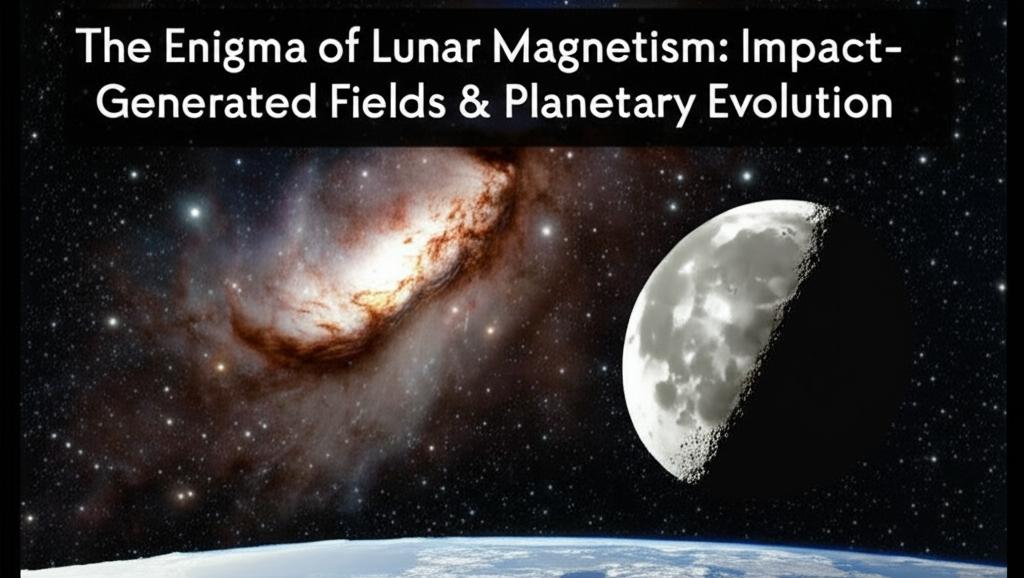The Moon, our silent celestial partner, holds a magnetic mystery that has captivated scientists for decades. While it lacks a global magnetic field today, evidence abounds of an ancient, powerful magnetism locked within its rocks and crust. This enduring enigma offers clues not only to the Moon's own turbulent past but also to the broader processes of planetary evolution.
For years, the leading theory for the Moon's ancient magnetism was a core dynamo, similar to Earth's, where the churning of a molten metallic core generates a magnetic field. Analyses of Apollo samples and orbital magnetic field data indeed show that the Moon once had a global magnetic field, likely operating from about 4.25 billion years ago until sometime between 1.92 and 0.8 billion years ago. At certain points, this field may have rivaled the strength of modern Earth's.
However, the Moon's small core presents a challenge to this theory. It's questionable whether such a small core could have generated and sustained a magnetic field strong enough and for long enough to explain the magnetized lunar rocks we observe. This has spurred scientists to explore alternative or complementary mechanisms, with a strong focus on the cataclysmic impacts that pockmarked the young Moon's surface.
Recent research, particularly from scientists at MIT, has breathed new life into the idea that massive asteroid impacts played a crucial role in generating strong, localized magnetic fields. Computer simulations suggest that a large asteroid impact could vaporize surface material, creating a vast, expanding cloud of superheated, electrically charged particles – a plasma. This plasma cloud, enveloping the Moon, could have interacted with and dramatically amplified any existing weak lunar magnetic field, particularly on the side of the Moon opposite the impact (the antipode).
Imagine the scene: a colossal asteroid strikes the Moon. As seismic waves from the impact race through the lunar interior and converge at the antipode, the expanding plasma cloud, carrying and compressing magnetic field lines, arrives almost simultaneously. This combination could have created a temporarily intense magnetic field, strong enough to magnetize rocks in that region as they cooled. This could explain why some of the strongest magnetic anomalies are found antipodal to large impact basins like Imbrium, Crisium, Orientale, and Serenitatis. The simulations indicate that the plasma-compressed magnetic field strength at an impact's antipode could have been significantly amplified, even if the Moon's intrinsic dynamo-generated field was relatively weak.
This impact-generated field hypothesis doesn't necessarily negate the existence of an early lunar dynamo. In fact, some models suggest a synergy between the two. A weaker core dynamo might have provided the initial magnetic field that was then locally and temporarily amplified by impact-generated plasmas. Other theories propose that impacts themselves could have influenced the core dynamo. The sheer energy of basin-forming impacts might have been sufficient to alter the Moon's rotation rate, with the subsequent large-scale fluid flows in the core, excited by tidal forces, potentially powering a lunar dynamo.
The study of lunar magnetism is far from over. While impact-generated plasmas offer a compelling explanation for some of the Moon's strongest magnetic signatures, particularly on the farside, there are still many magnetized regions that don't neatly fit this antipodal pattern. Scientists are also investigating other factors, such as the possibility that some magnetic carriers were delivered by the impacting asteroids themselves, or the role of a potential basal magma ocean in powering a dynamo.
Unraveling the enigma of lunar magnetism is crucial for understanding the Moon's thermal history, the evolution of its core and mantle, and the physics of large impact events. These insights extend beyond the Moon, helping us understand the magnetic histories of other planetary bodies like Mars, which also exhibits crustal magnetism, and even Mercury, which still possesses a core dynamo. The Moon, therefore, serves as a unique natural laboratory for studying the complex interplay of internal planetary processes and external cosmic bombardment in shaping a celestial body's magnetic destiny and, by extension, its overall evolution. Future missions, potentially returning oriented samples from strategically chosen magnetized regions, will be key to further testing these fascinating theories.

